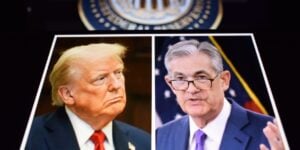In October 2008, the Federal Reserve changed its monetary-policy regime. Traditionally, it had targeted interest rates using a corridor system. By adopting a new policy of paying interest on reserves, it moved to a floor system. What prompted the regime change?
Let’s start with the decision to pay interest on reserves. The standard argument for paying interest on reserves is straightforward. If the rate of return on reserves is less than the rate of return on similar short-term assets, banks will hold too few reserves. In theory, the Fed could require banks to hold the optimal amount of reserves. But it is difficult to estimate the optimal amount of reserves for a particular bank. To avoid this difficulty, the Fed can simply give banks the incentive to hold the optimal amount of reserves by paying interest on reserves equal to the rate of return on comparable short-term assets.
In passing the Financial Services Regulatory Relief Act of 2006, Congress authorized the Federal Reserve to begin paying interest on reserves on October 1, 2011. In fact, the Fed began paying interest on reserves much sooner — and for very different reasons. As the Federal Reserve Bank of San Francisco notes:
The effective date was moved up by three years through the Emergency Economic Stabilization Act of 2008. This was important for monetary policy because the Federal Reserve’s various liquidity facilities initiated during the financial crisis caused upward pressure on excess reserves and placed downward pressure on the Federal funds rate. To counteract these pressures, on October 6, 2008, the Federal Reserve Board announced that it would begin paying interest on depository institutions’ reserve balances.
There’s a lot in that statement. Let’s unpack it.
Fearing a collapse of the financial system, the Fed began increasing its lending to financial institutions in January 2008. In July 2008, it also increased its lending to key credit markets. Normally, such an increase in lending would cause the Fed’s balance sheet to swell and, in time, the price level to rise. However, the Fed offset this lending by selling Treasuries, thereby keeping a lid on inflation.
In September 2008, the Fed embarked on a massive lending program. Its loans to financial institutions increased from around $550.1 billion in early September to $1,571.2 billion by mid-November. Its loans to key credit markets increased from $29.2 billion to $362.4 billion over the same period. There was just one problem: the Fed did not hold enough Treasuries to cover the lending and other asset purchases it thought necessary. It would have to create new reserves.
In the absence of some offsetting policy, the creation of new reserves is inflationary. New reserves get deposited in banks, which hold a fraction and lend out the rest. Those loans get spent, deposited, and lent out again. As the new money makes its way through the economy, prices are bid up. How, then, could the Fed increase the size of its balance sheet to the extent it thought necessary without putting upward pressure on inflation? The solution it landed on was to begin paying interest on reserves.
By paying interest on reserves (more specifically, paying a rate of interest greater than financial institutions could get from holding similar assets), the Fed could prevent banks from lending out the new reserves it was dead set on creating. Instead, banks would just sit on the new reserves and collect interest payments from the Fed. If banks refused to lend reserves, those funds would not get spent, deposited, and lent out. And if those funds did not circulate throughout the economy, prices would not be bid up. Hence, the Fed could prevent the expansion in its balance sheet from causing inflation by paying interest on reserves.
Recall that the initial justification for paying interest on reserves was to prevent banks from holding too few reserves. To accomplish this, the Fed would need to pay a rate of interest comparable to that on similar assets. Inducing banks to sit on reserves, in contrast, required paying a rate greater than that paid on similar assets. Such a policy induces banks to hold too many reserves. It establishes a floor system, wherein traditional open market operations fail to increase nominal spending.






